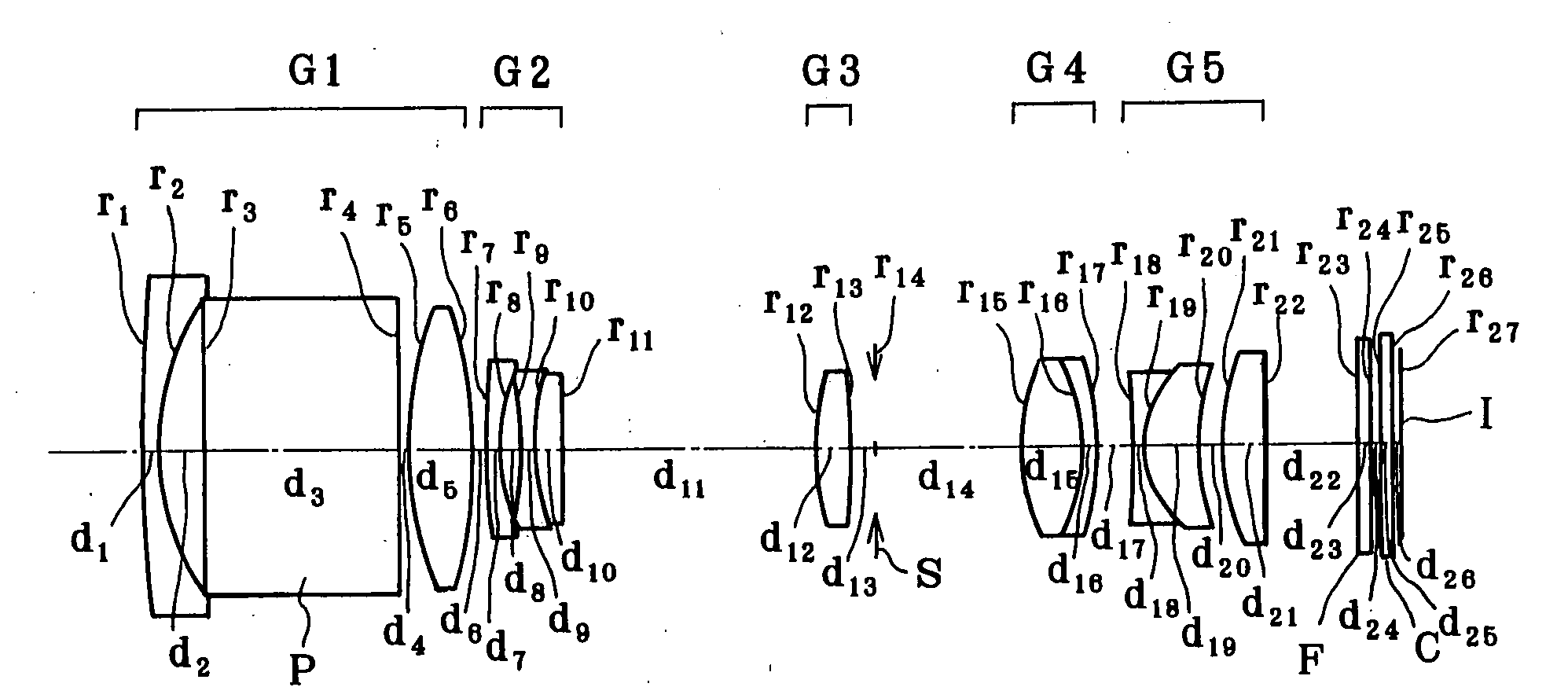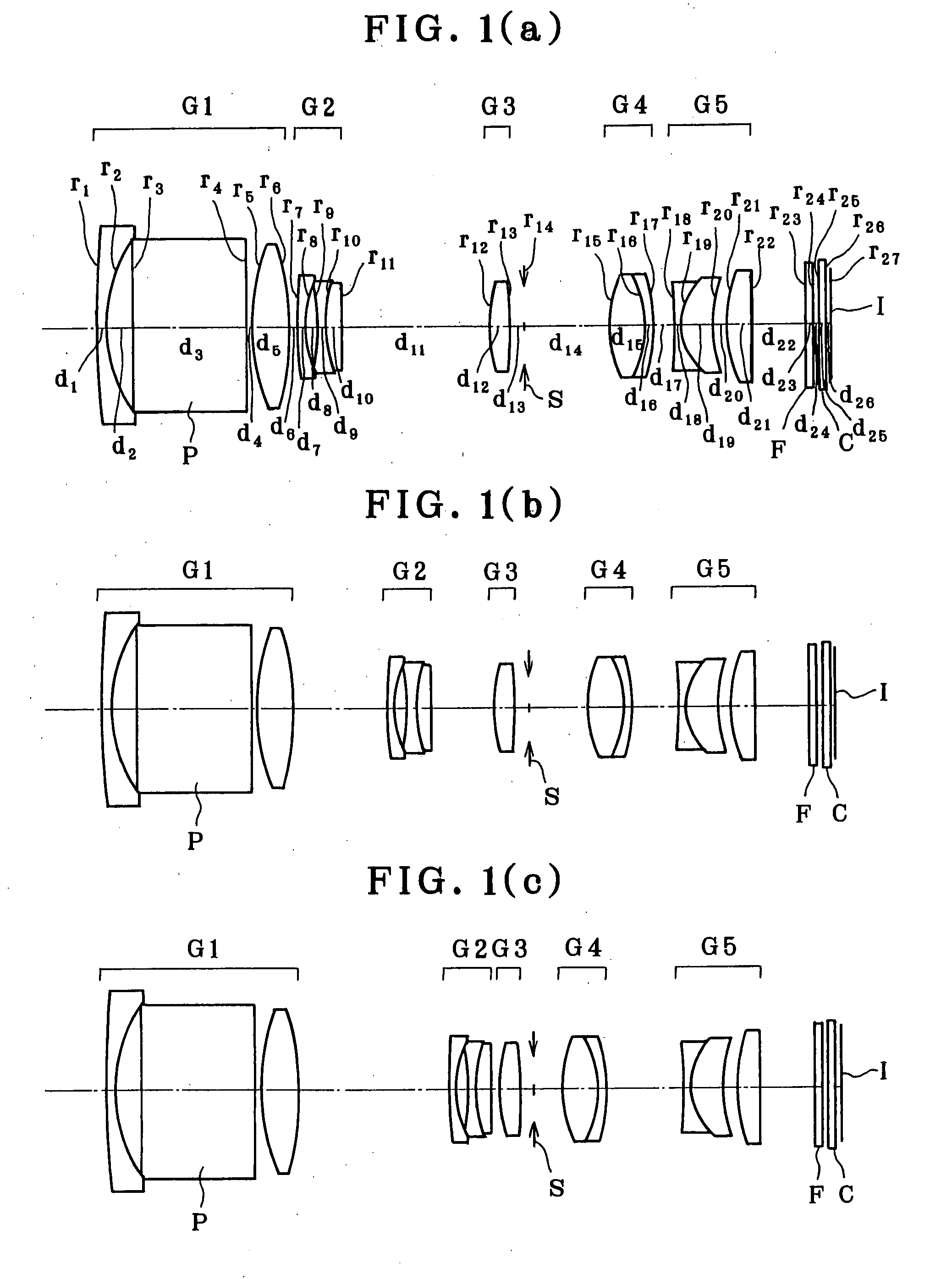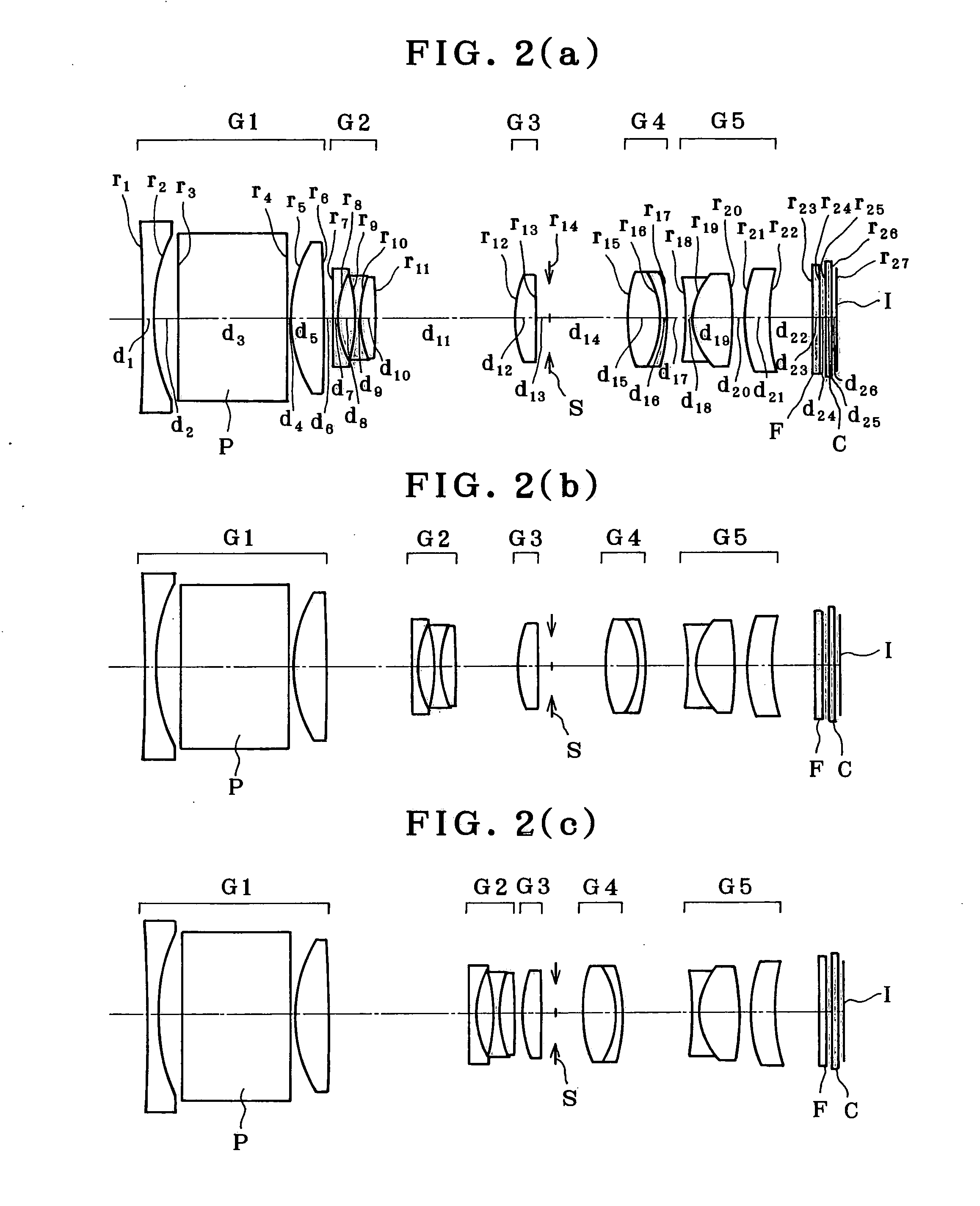Zoom lens and imaging system using the same
a zoom lens and imaging system technology, applied in the field of zoom lens and imaging system, can solve the problems of inconvenient operation, the thickness of the optical system is the biggest bottleneck in reducing the depth dimension of the camera, and the use of the collapsible lens mount is not preferable in view of ease of operation, so as to prevent moisture and dust entry, easy to bend, and high optical performance
- Summary
- Abstract
- Description
- Claims
- Application Information
AI Technical Summary
Benefits of technology
Problems solved by technology
Method used
Image
Examples
example 1
[0077]
r1 = 79.245d1 = 0.80nd1 = 2.00069νd1 = 25.46r2 = 10.737d2 = 1.85r3 = ∞d3 = 8.40nd2 = 2.00330νd2 = 28.27r4 = ∞d4 = 0.30r5 = 15.402 (Aspheric)d5 = 2.67nd3 = 1.76802νd3 = 49.24r6 = −22.552 (Aspheric)d6 = (Variable)r7 = 40.183d7 = 0.50nd4 = 1.88300νd4 = 40.76r8 = 7.191d8 = 1.07r9 = −14.386d9 = 0.45nd5 = 1.88300νd5 = 40.76r10 = 8.265d10 = 1.15nd6 = 1.92286νd6 = 20.88r11 = −8422.538d11 =(Variable)r12 = 9.608 (Aspheric)d12 = 1.54nd7 = 1.62299νd7 = 58.12r13 = −38.385 (Aspheric)d13 = 1.00r14 = ∞ (Stop)d14 =(Variable)r15 = 8.672 (Aspheric)d15 = 2.61nd8 = 1.62299νd8 = 58.12r16 = −6.739d16 = 0.54nd9 = 1.92286νd9 = 20.88r17 = −11.899d17 =(Variable)r18 = −44.226d18 = 0.50nd10 = 2.00330νd10 = 28.27r19 = 4.235d19 = 2.37nd11 = 1.51633νd11 = 64.14r20 = 9.498d20 = 0.94r21 = 10.761d21 = 1.80nd12 = 1.84666νd12 = 23.78r22 = −602.041d22 = 3.88r23 = ∞d23 = 0.50nd13 = 1.51680νd13 = 64.20r24 = ∞d24 = 0.50r25 = ∞d25 = 0.50nd14 = 1.51680νd14 = 64.20r26 = ∞d26 = 0.37r27 = ∞ (Imaging plane)Aspherical Coeff...
example 2
[0078]
r1 = −153.902d1 = 0.80nd1 = 2.00170νd1 = 20.60r2 = 12.979d2 = 1.91(Aspheric)r3 = ∞d3 = 8.50nd2 = 1.90366νd2 = 31.31r4 = ∞d4 = 0.30r5 = 10.604d5 = 2.58nd3 = 1.80139νd3 = 45.45(Aspheric)r6 = −74.045d6 = (Variable)(Aspheric)r7 = 180.770d7 = 0.50nd4 = 1.88300νd4 = 40.76r8 = 7.336d8 = 1.28r9 = −14.370d9 = 0.45nd5 = 1.88300νd5 = 40.76r10 = 8.729d10 = 1.15nd6 = 1.92286νd6 = 20.88r11 = −62.471d11 = (Variable)r12 = 8.946d12 = 1.54nd7 = 1.67790νd7 = 55.34(Aspheric)r13 = −116.820d13 = 1.00(Aspheric)r14 = ∞ (Stop)d14 = (Variable)r15 = 9.447d15 = 2.58nd8 = 1.62299νd8 = 58.12(Aspheric)r16 = −6.914d16 = 0.54nd9 = 1.92286νd9 = 20.88r17 = −12.280d17 = (Variable)r18 = −20.311d18 = 0.50nd10 = 2.00330νd10 = 28.27r19 = 5.042d19 = 3.10nd11 = 1.51633νd11 = 64.14r20 = −23.168d20 = 0.90r21 = 11.413d21 = 1.80nd12 = 1.84666νd12 = 23.78r22 = 14.325d22 = 3.32r23 = ∞d23 = 0.50nd13 = 1.51680νd13 = 64.20r24 = ∞d24 = 0.50r25 = ∞d25 = 0.50nd14 = 1.51680νd14 = 64.20r26 = ∞d26 = 0.37r27 = ∞(Imagingplane)Aspheric...
example 3
[0079]
r1 = 94.193d1 = 0.80nd1 = 2.00069νd1 = 25.46r2 = 10.777d2 = 1.90r3 = ∞d3 = 8.40nd2 = 2.00330νd2 = 28.27r4 = ∞d4 = 0.30r5 = 15.253d5 = 2.67nd3 = 1.76802νd3 = 49.24(Aspheric)r6 = −22.635d6 = (Variable)(Aspheric)r7 = 30.598d7 = 0.50nd4 = 1.88300νd4 = 40.76r8 = 7.008d8 = 1.08r9 = −14.944d9 = 0.45nd5 = 1.88300νd5 = 40.76r10 = 7.893d10 = 1.12nd6 = 1.92286νd6 = 20.88r11 = 162.059d11 = (Variable)r12 = 9.600d12 = 1.54nd7 = 1.62299νd7 = 58.12(Aspheric)r13 = −37.829d13 = 1.00(Aspheric)r14 = ∞ (Stop)d14 = (Variable)r15 = 8.474d15 = 2.66nd8 = 1.62299νd8 = 58.12(Aspheric)r16 = −6.619d16 = 0.54nd9 = 1.92286νd9 = 20.88r17 = −11.728d17 = (Variable)r18 = −29.689d18 = 0.50nd10 = 2.00330νd10 = 28.27r19 = 4.379d19 = 2.19nd11 = 1.51633νd11 = 64.14r20 = 10.038d20 = 0.97r21 = 12.327d21 = 1.80nd12 = 1.84666νd12 = 23.78r22 = −68.566d22 = 4.01r23 = ∞d23 = 0.50nd13 = 1.51680νd13 = 64.20r24 = ∞d24 = 0.50r25 = ∞d25 = 0.50nd14 = 1.51680νd14 = 64.20r26 = ∞d26 = 0.37r27 = ∞(Imagingplane)Aspherical Coefficient...
PUM
 Login to View More
Login to View More Abstract
Description
Claims
Application Information
 Login to View More
Login to View More - R&D
- Intellectual Property
- Life Sciences
- Materials
- Tech Scout
- Unparalleled Data Quality
- Higher Quality Content
- 60% Fewer Hallucinations
Browse by: Latest US Patents, China's latest patents, Technical Efficacy Thesaurus, Application Domain, Technology Topic, Popular Technical Reports.
© 2025 PatSnap. All rights reserved.Legal|Privacy policy|Modern Slavery Act Transparency Statement|Sitemap|About US| Contact US: help@patsnap.com



